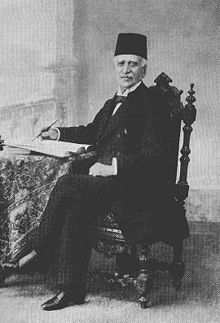- Mirza Malkam Khan
-
Mirza Malkam Khan (1833-1908), also spelled as Malkom Khan, was a prominent Iranian modernist, preoccupied with the transformation of Iran into a modern state. The most remarkable aspect of his work was his promotion of 'law', to bring about an orderly society in which royal power was subjected or 'conditioned' (mashrut) to checks and regulations. He developed these ideas in a number of works, but most importantly in his newspaper Qanun (Law), which had a wide readership among Iran's modernists. As such, he can be considered one of the fathers of the Iranian Constitutional Revolution.
Malkam Khan was born to an Armenian Christian family in Persia[1] and educated at the Samuel Muradian school in Paris from 1843–51. He later returned to Persia, converted to Islam,[2] and entered government service. He was elected as instructor at the newly established Tehran Polytechnic, Dar ul-Funun, in 1852. He went to Paris in the diplomatic service in 1857.[3]
Malkom Khan introduced societies similar to the Freemasons in Persia in 1859, and was exiled by Nasser ad-Din Shah for doing so in 1862. He was later pardoned and given a post at the embassy in Constantinople. He returned to Tehran in 1872 as assistant to Grand Vizier Mirza Hasan Khan Pirnia, Moshir od-Dowleh, and became the chief of the Persian legation in London (and later ambassador) in 1872. He remained in the position until 1888, and lost his position in 1889 as the result of a scandal over selling a cancelled concession for a lottery.[4]
From London, Malkam Khan attacked both the shah and Persian government, and edited the news-sheet Qanun, which was banned in Persia but read by the shah and his ministers. Malkam Khan eventually became recognised as the most important Persian moderniser of the century, and he was later pardoned and reinstated as ambassador to Italy by Mozaffar ad-Din Shah in 1898 with the title of Nezam od-Dowleh. He remained ambassador to Italy until his death in 1908.[5]
References
- ^ Lloyd Ridgeon, Religion and Politics in Modern Iran (I.B.Tauris, 2005), ISBN 1845110722. p. 14.
- ^ The Iranian constitutional revolution, 1906-1911, by By Janet Afary, pg. 26
- ^ Nikki R. Keddie, with a section by Yann Richard, Modern Iran: Roots and Results of Revolution (Yale University Press, New Haven, 2006), ISBN 0-300-12105-9. pp. 431-32.
- ^ Nikki R. Keddie, ibid., pp. 431-32.
- ^ Nikki R. Keddie, ibid., pp. 431-32.
Further reading
- Mehrdad Kia, Pan-Islamism in Late Nineteenth-Century Iran, Middle Eastern Studies, Vol. 32, No. 1, pp. 30-52 (1996).
Categories:- 1833 births
- 1908 deaths
- Converts to Islam
- Persian Armenians
- Iranian diplomats
- Iranian Shi'a Muslims
- Inventors of writing systems
- Ambassadors of Iran to Italy
- Armenian Shi'a Muslims
Wikimedia Foundation. 2010.

